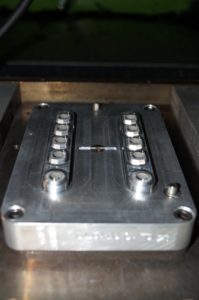There are various methods of injecting silicone rubber into a mold, some good and some bad. Two very important things to consider when designing an injection mold are the runner system & gating. Depending on the number of cavities you decide to run within your silicone mold, a balance of flow may be needed. Knowing these methods before designing your tooling can save time & money by decreasing the chance of having to make tooling modifications.
Having a runner system designed properly can give multiple benefits to the final outcome of you silicone injection mold.
These benefits include:
- Minimizing Waste
- Having to large of a runner for the part you are trying to fill will waste silicone rubber and adds up over large quantity orders.
- Balancing multiple cavities
- In most cases, not balancing the flow of material can have some adverse effects. From our experience material flows the path of least resistance. This means that on an unbalanced runner, the cavity of least resistance will be filled with more material vs. other cavities. This can cause issues with critical dimensions & tolerances.
- Ease of manufacturing
- A well-designed runner system can help manufacturing with secondary processes. Having the part spacing & runner system linking all of the cavities in a specific pattern can make handling the product that much easier.
- Optimal number of Cavities
- Setting the optimal number of cavities can be a bit tricky, but a common rule of thumb is to have a specific number of cavities to help balance the flow of material. This number increases exponentially starting with 1, 2, 4, 8, 16, etc… Having an odd number of cavities other than 1, can cause the flow of material to be uneven within the mold.
Another mold feature that has an effect on the outcome of the part is the mold gate. There are various types of gates but the main 3 types used here at SiTECH are: Sprue Gate, Tab Gate, & Tunnel Gate or Sub Gate. Each gate has its own benefits & disadvantages to the others.
Gates:
A sprue gate is a gate that injects directly into the part with no runner system. This is typically only done on large parts or hard to fill parts. Sprue gates are typically placed on the non-visual side of the part due to the large trim that needs to take place to remove it.
Tab Gates are ran directly off of the runner into the side of the part. These are very beneficial in the ease of handling the parts if you have multiple secondary operations. You can transport large amounts of parts on one runner.
Tunnel gates allow injection points in hard to reach areas, or the bottom of the part. These are typically done when no visual marks are allowed on the side of the part. These gates can also be used to help the part fill correctly & not trap air.
At SiTECH, we only use liquid silicone for all of our products, allowing us to be more dependable in duplicating our processes. We have made silicone products for many industries, and we would love to help you with your next product, contact us today!










